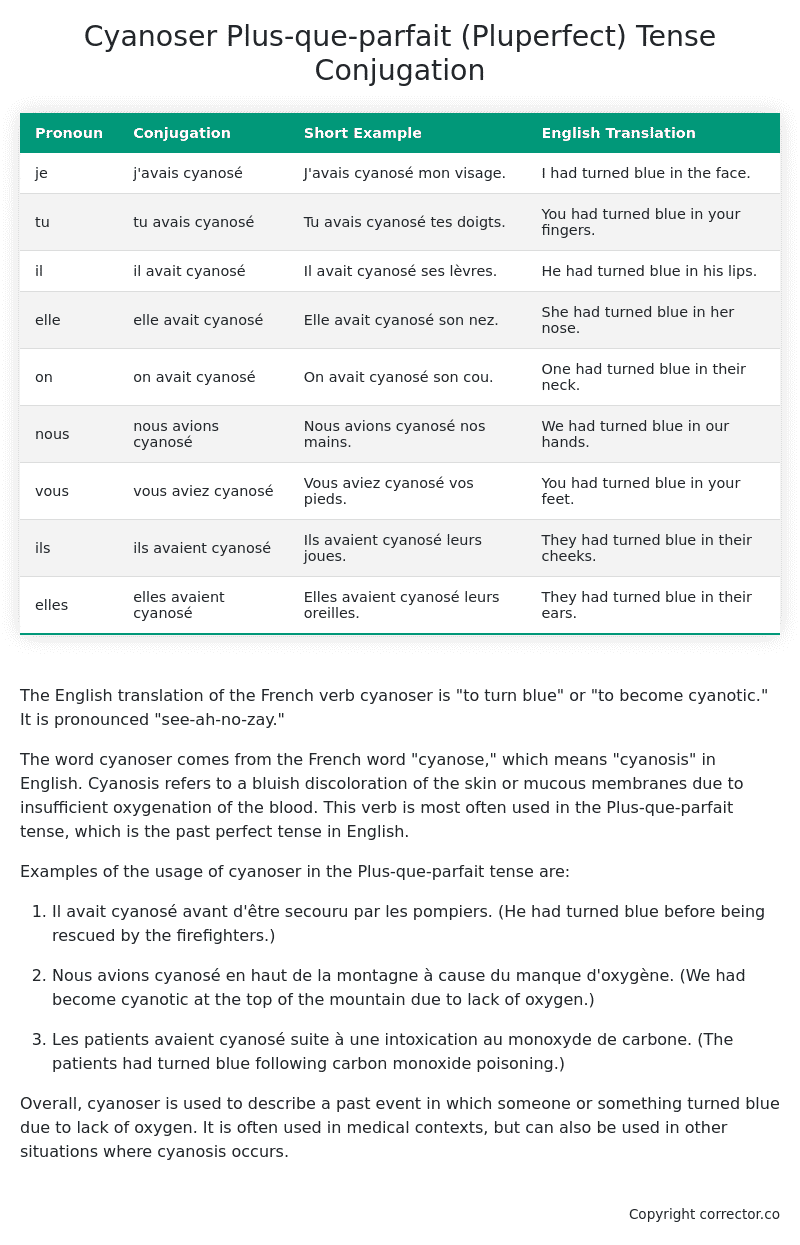Plus-que-parfait (Pluperfect) Tense Conjugation of the French Verb cyanoser
Introduction to the verb cyanoser
The English translation of the French verb cyanoser is “to turn blue” or “to become cyanotic.” It is pronounced “see-ah-no-zay.”
The word cyanoser comes from the French word “cyanose,” which means “cyanosis” in English. Cyanosis refers to a bluish discoloration of the skin or mucous membranes due to insufficient oxygenation of the blood. This verb is most often used in the Plus-que-parfait tense, which is the past perfect tense in English.
Examples of the usage of cyanoser in the Plus-que-parfait tense are:
-
Il avait cyanosé avant d’être secouru par les pompiers. (He had turned blue before being rescued by the firefighters.)
-
Nous avions cyanosé en haut de la montagne à cause du manque d’oxygène. (We had become cyanotic at the top of the mountain due to lack of oxygen.)
-
Les patients avaient cyanosé suite à une intoxication au monoxyde de carbone. (The patients had turned blue following carbon monoxide poisoning.)
Overall, cyanoser is used to describe a past event in which someone or something turned blue due to lack of oxygen. It is often used in medical contexts, but can also be used in other situations where cyanosis occurs.
Table of the Plus-que-parfait (Pluperfect) Tense Conjugation of cyanoser
| Pronoun | Conjugation | Short Example | English Translation |
|---|---|---|---|
| je | j’avais cyanosé | J’avais cyanosé mon visage. | I had turned blue in the face. |
| tu | tu avais cyanosé | Tu avais cyanosé tes doigts. | You had turned blue in your fingers. |
| il | il avait cyanosé | Il avait cyanosé ses lèvres. | He had turned blue in his lips. |
| elle | elle avait cyanosé | Elle avait cyanosé son nez. | She had turned blue in her nose. |
| on | on avait cyanosé | On avait cyanosé son cou. | One had turned blue in their neck. |
| nous | nous avions cyanosé | Nous avions cyanosé nos mains. | We had turned blue in our hands. |
| vous | vous aviez cyanosé | Vous aviez cyanosé vos pieds. | You had turned blue in your feet. |
| ils | ils avaient cyanosé | Ils avaient cyanosé leurs joues. | They had turned blue in their cheeks. |
| elles | elles avaient cyanosé | Elles avaient cyanosé leurs oreilles. | They had turned blue in their ears. |
Other Conjugations for Cyanoser.
Le Present (Present Tense) Conjugation of the French Verb cyanoser
Imparfait (Imperfect) Tense Conjugation of the French Verb cyanoser
Passé Simple (Simple Past) Tense Conjugation of the French Verb cyanoser
Passé Composé (Present Perfect) Tense Conjugation of the French Verb cyanoser
Futur Simple (Simple Future) Tense Conjugation of the French Verb cyanoser
Futur Proche (Near Future) Tense Conjugation of the French Verb cyanoser
Plus-que-parfait (Pluperfect) Tense Conjugation of the French Verb cyanoser (this article)
Passé Antérieur (Past Anterior) Tense Conjugation of the French Verb cyanoser
Futur Antérieur (Future Anterior) Tense Conjugation of the French Verb cyanoser
Subjonctif Présent (Subjunctive Present) Tense Conjugation of the French Verb cyanoser
Subjonctif Passé (Subjunctive Past) Tense Conjugation of the French Verb cyanoser
Subjonctif Imparfait (Subjunctive Imperfect) Tense Conjugation of the French Verb cyanoser
Subjonctif Plus-que-parfait (Subjunctive Pluperfect) Tense Conjugation of the French Verb cyanoser
Conditionnel Présent (Conditional Present) Tense Conjugation of the French Verb cyanoser
Conditionnel Passé (Conditional Past) Tense Conjugation of the French Verb cyanoser
L’impératif Présent (Imperative Present) Tense Conjugation of the French Verb cyanoser
L’infinitif Présent (Infinitive Present) Tense Conjugation of the French Verb cyanoser
Struggling with French verbs or the language in general? Why not use our free French Grammar Checker – no registration required!
Get a FREE Download Study Sheet of this Conjugation 🔥
Simply right click the image below, click “save image” and get your free reference for the cyanoser Plus-que-parfait tense conjugation!

Cyanoser – About the French Plus-que-parfait (Pluperfect) Tense
Tense Formation
Common everyday usage patterns
Sequencing of past events
Background information
Hypothetical or reported speech
Interactions with other tenses
Summary
I hope you enjoyed this article on the verb cyanoser. Still in a learning mood? Check out another TOTALLY random French verb conjugation!


